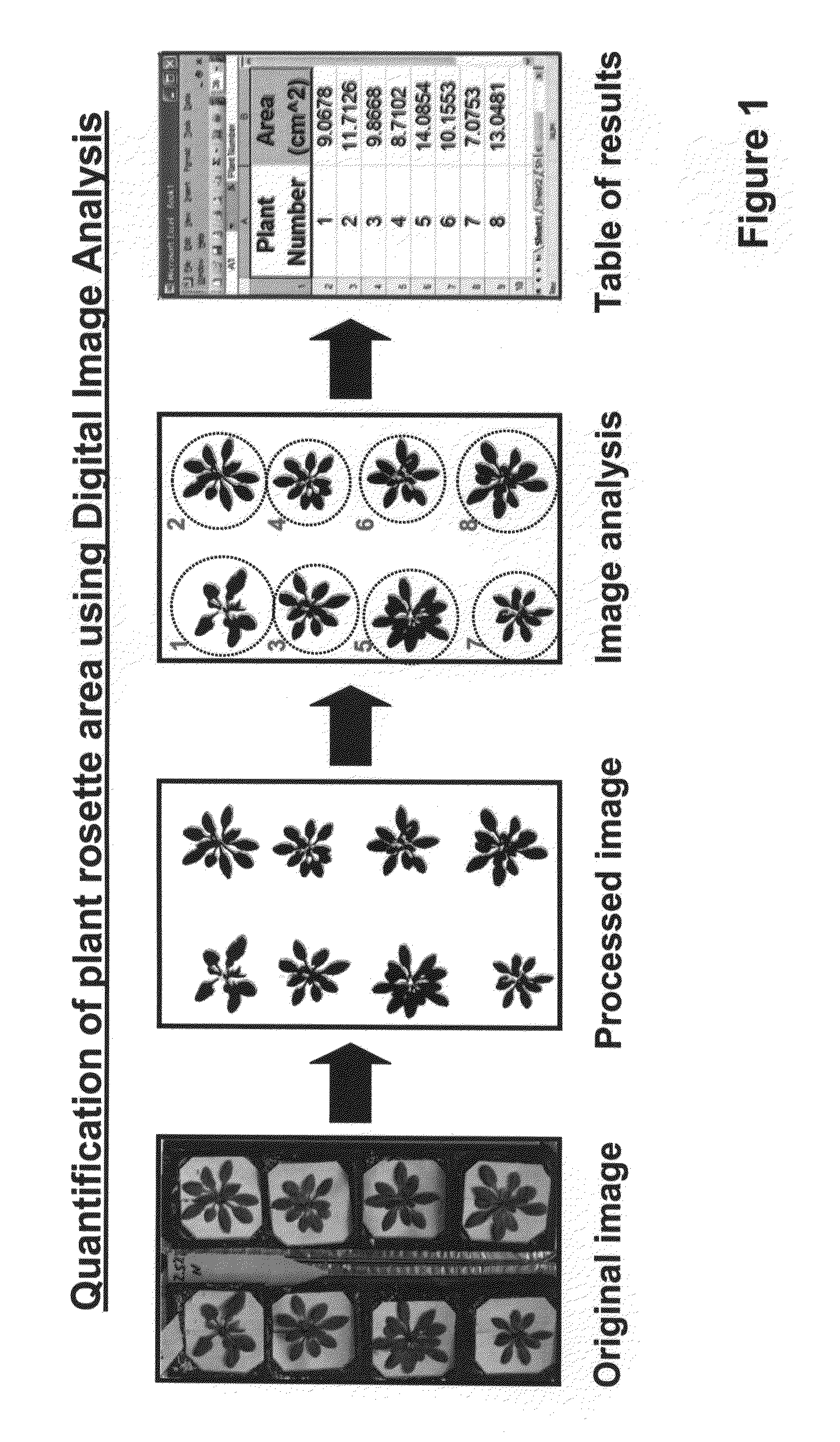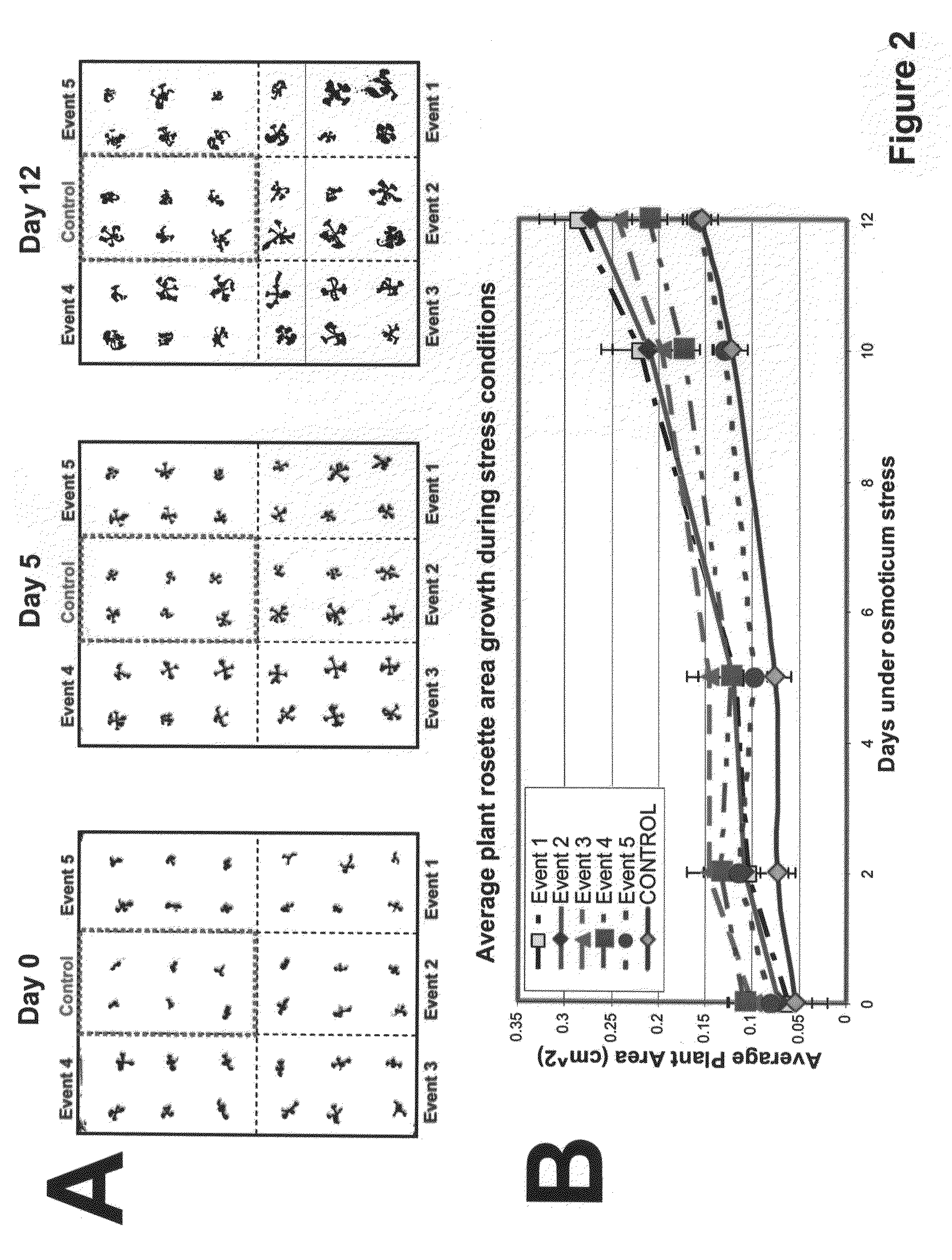Methods of increasing abiotic stress tolerance and/or biomass in plants and plants generated thereby
a technology of abiotic stress tolerance and biomass, which is applied in the direction of plant/algae/fungi/lichens, peptides, tissue culture, etc., can solve the problems of profound effects on plant development, growth and yield of most crop plants, cell death and consequently yield loss, etc., to increase the tolerance of plants
- Summary
- Abstract
- Description
- Claims
- Application Information
AI Technical Summary
Benefits of technology
Problems solved by technology
Method used
Image
Examples
example 1
Identifying Putative Abiotic Stress-Tolerance Genes from Monocots
[0144]Abiotic stress-tolerance (ABST) genes were identified and validated in vivo as previously described WO2004 / 104162 to the present assignee. A number of ABS genes and polypeptides encoded thereby were identified from dicot plants (SEQ ID NOs. 122-126 and 127-131, respectively). Screen for orthologous sequences was performed on monocot genomic databases, NCBI (Hypertext Transfer Protocol: / / World Wide Web (dot) ncbi (dot) nlm (dot) nih (dot) gov), and TIGR (Hypertext Transfer Protocol: / / World Wide Web (dot) tigr (dot) org / ) databases of Maize, Sorghum, Rice and Barley.
[0145]The expressed sequence tags (ESTs) and cDNA sequences were clustered and assembled using the LEADS™ software (Compugen) and compared to the TIGR Hypertext Transfer Protocol: / / World Wide Web (dot) tigr (dot) org / ) databases of the above monocots. Overall, clustering of 372,000 maize ESTs resulted in 41,990 clusters among them 19,870 singletones. In...
example 2
Generating the Putative Monocot ABST Genes
[0162]DNA sequences of the monocot ABST genes were synthesized by GeneArt (Hypertext Transfer Protocol: / / World Wide Web (dot) geneart (dot) com / ). Synthetic DNA was designed in silico, based on the encoded amino-acid sequences of the monocot ABST genes (SEQ ID Nos 2, 4, 6, 12) and using codon-usage tables calculated from plant transcriptomes (example of such tables can be found in the Codon Usage Database available online at Hypertext Transfer Protocol: / / World Wide Web (dot) kazusa (dot) or (dot) jp / codon / ). The optimized coding sequences are designed in a way that no changes are introduced in the encoded amino acid sequence while using codons preferred for expression in dicotyledonous plants (mainly tomato and Arabidopsis) and monocotyledonous plants such as maize. At least one silent mutation per 20 nucleotide base pairs was introduced in the sequence compared to the orthologous monocot sequences to avoid possible silencing when over-expre...
example 3
Cloning the Putative ABST Genes
[0163]The PCR Script plasmids harboring the synthetic, monocot-based ABST genes were digested with the restriction endonucleases XbaI and SacI (Roche). The resulting fragment was purified using Gel extraction Kit (Qiagen, Germany) and ligated using T4 DNA ligase enzyme (Roche) into the plant expression vector pKG(NOSter), (SEQ ID NO 136), excised with the same enzymes. pKG plasmid is based on the PCR Script backbone, with several changes in the polylinker site to facilitate the cloning of genes of interest downstream to a promoter and upstream to a terminator suitable for expression in plant cells. As a result, the inserted gene, together with the promoter and the terminator can be easily moved to a binary vector.
[0164]The resulting pKG(NOSter) harboring putative monocot ABST genes were introduced to E. coli DH5 competent cells by electroporation, using a MicroPulser electroporator (Biorad), 0.2 cm cuvettes (Biorad) and EC-2 electroporation program (Bi...
PUM
| Property | Measurement | Unit |
|---|---|---|
| RH | aaaaa | aaaaa |
| salinity | aaaaa | aaaaa |
| temperature | aaaaa | aaaaa |
Abstract
Description
Claims
Application Information
 Login to View More
Login to View More - R&D
- Intellectual Property
- Life Sciences
- Materials
- Tech Scout
- Unparalleled Data Quality
- Higher Quality Content
- 60% Fewer Hallucinations
Browse by: Latest US Patents, China's latest patents, Technical Efficacy Thesaurus, Application Domain, Technology Topic, Popular Technical Reports.
© 2025 PatSnap. All rights reserved.Legal|Privacy policy|Modern Slavery Act Transparency Statement|Sitemap|About US| Contact US: help@patsnap.com


